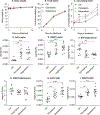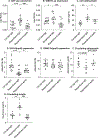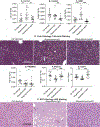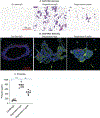Hyperleptinemia contributes to antipsychotic drug-associated obesity and metabolic disorders
- PMID: 37992151
- PMCID: PMC11755893
- DOI: 10.1126/scitranslmed.ade8460
Hyperleptinemia contributes to antipsychotic drug-associated obesity and metabolic disorders
Abstract
Despite their high degree of effectiveness in the management of psychiatric conditions, exposure to antipsychotic drugs, including olanzapine and risperidone, is frequently associated with substantial weight gain and the development of diabetes. Even before weight gain, a rapid rise in circulating leptin concentrations can be observed in most patients taking antipsychotic drugs. To date, the contribution of this hyperleptinemia to weight gain and metabolic deterioration has not been defined. Here, with an established mouse model that recapitulates antipsychotic drug-induced obesity and insulin resistance, we not only confirm that hyperleptinemia occurs before weight gain but also demonstrate that hyperleptinemia contributes directly to the development of obesity and associated metabolic disorders. By suppressing the rise in leptin through the use of a monoclonal leptin-neutralizing antibody, we effectively prevented weight gain, restored glucose tolerance, and preserved adipose tissue and liver function in antipsychotic drug-treated mice. Mechanistically, suppressing excess leptin resolved local tissue and systemic inflammation typically associated with antipsychotic drug treatment. We conclude that hyperleptinemia is a key contributor to antipsychotic drug-associated weight gain and metabolic deterioration. Leptin suppression may be an effective approach to reducing the undesirable side effects of antipsychotic drugs.
Conflict of interest statement
Figures







Comment in
-
Antibodies achieve leptin balancing act.Nat Rev Drug Discov. 2024 Jan;23(1):21. doi: 10.1038/d41573-023-00203-9. Nat Rev Drug Discov. 2024. PMID: 38057454 No abstract available.
References
-
- Henderson DC, Weight gain with atypical antipsychotics: evidence and insights. J Clin Psychiatry 68 Suppl 12, 18–26 (2007). - PubMed
MeSH terms
Substances
Grants and funding
- R01 DK088423/DK/NIDDK NIH HHS/United States
- R01 DK136619/DK/NIDDK NIH HHS/United States
- R01 DK130892/DK/NIDDK NIH HHS/United States
- P01 AG051459/AG/NIA NIH HHS/United States
- R00 AG068239/AG/NIA NIH HHS/United States
- R01 DK138035/DK/NIDDK NIH HHS/United States
- R01 DK099110/DK/NIDDK NIH HHS/United States
- R01 DK131537/DK/NIDDK NIH HHS/United States
- R01 DK055758/DK/NIDDK NIH HHS/United States
- R01 DK136532/DK/NIDDK NIH HHS/United States
- P30 DK127984/DK/NIDDK NIH HHS/United States
- R01 DK118725/DK/NIDDK NIH HHS/United States
- R01 DK117872/DK/NIDDK NIH HHS/United States
- R01 DK127274/DK/NIDDK NIH HHS/United States
- R01 DK114036/DK/NIDDK NIH HHS/United States
- RC2 DK118620/DK/NIDDK NIH HHS/United States
LinkOut - more resources
Full Text Sources
Medical

